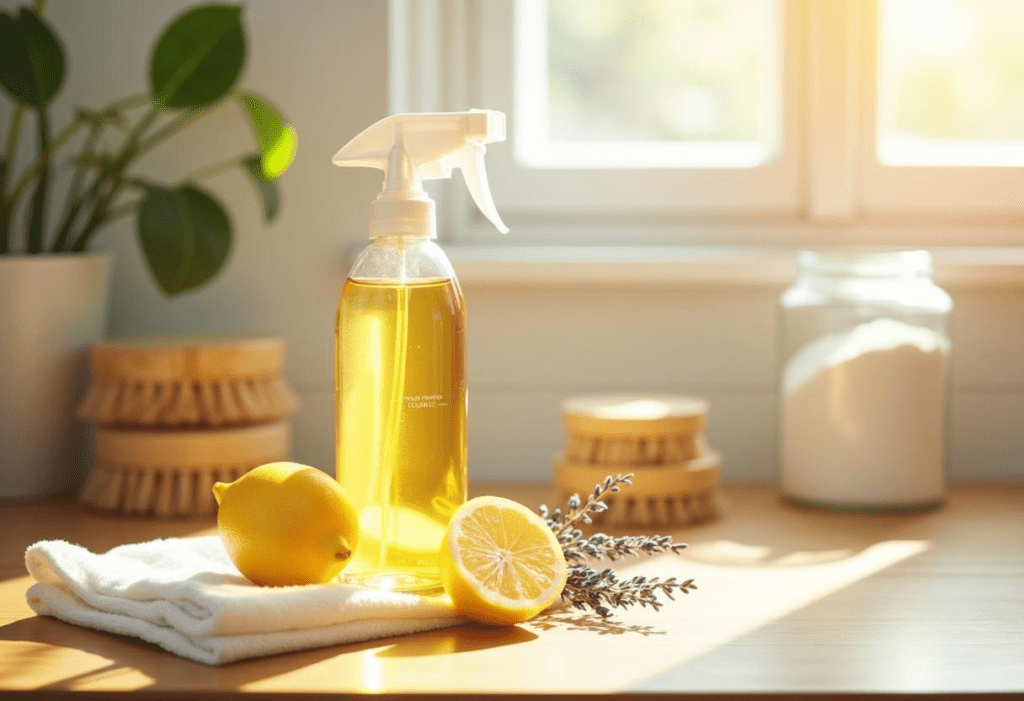Imagine this: a home buzzing with life, where messes bloom like wildflowers after a storm. Sticky spills, greasy smudges, and the occasional glitter explosion (thanks, craft night) are my reality. I’ve got a sprawling family and a passion for keeping things green, which is why I traded harsh, chemical-drenched cleaners for non-toxic alternatives. Those lush, plant-powered bottles promise a spotless sanctuary without the toxic sting. But here’s the million-dollar question that haunts every eco-warrior: Do they really work? Let’s peel back the science, test their mettle, and reveal the dazzling truth—because a clean home shouldn’t cost us the planet.
Why Non-Toxic Cleaners Captivated Me
I’ve always been drawn to the earth’s heartbeat—its rivers, forests, and the air we all share. That’s why my blog pulses with eco-friendly cleaning tips, ethical clothing finds, and sustainable kitchenware gems. Non-toxic cleaners fit this vibe like a glove. They shun the usual suspects—ammonia’s bite, chlorine’s burn, synthetic fragrances’ fakery—and embrace ingredients that feel safe, pure, alive. No more coughing through fumes or worrying about what’s seeping into my skin. But promises are one thing; performance is another. Could these gentle rebels scrub my home as fiercely as their chemical cousins? I had to know.
The Science: How Non-Toxic Cleaners Slay Dirt
Let’s get nerdy—because there’s nothing sexier than cracking the code behind a sparkling counter. Non-toxic cleaners wield a lineup of natural powerhouses: vinegar, baking soda, essential oils, and plant-derived surfactants. These aren’t just trendy buzzwords; they’re chemistry’s secret weapons.
Vinegar’s acetic acid (pH 2-3) is a feisty little beast, dissolving limescale from your kettle and slicing through grime with a tangy zing. Add baking soda (pH 9), and you’ve got a fizzing, bubbling duo that lifts dirt like a dream—think of it as nature’s own volcano, minus the cleanup. It’s simple, satisfying, and oh-so-effective.
Then there’s the muscle: plant-based surfactants. Sourced from coconut or corn, these clever molecules have a water-loving head and an oil-loving tail. They seduce grease and filth off surfaces, wrapping them up and rinsing them away in a silky swoosh. Studies from the Journal of Surfactants and Detergents back this up—natural surfactants rival synthetic ones for everyday grime, like spilled jam or stovetop splatters.
Essential oils bring more than their intoxicating scents—lemon’s citrus kiss, lavender’s soothing whisper. Oils like tea tree deliver an antimicrobial punch. Research from the American Society for Microbiology shows tea tree oil zaps bacteria like E. coli on contact, leaving surfaces not just clean, but safe. It’s a double win: a home that gleams and a conscience that glows.
Do They Deliver? My Real-World Test
Science is cute, but my house is a proving ground. With a lively crew and a knack for chaos, I don’t mess around when it comes to cleaning. So, I put these non-toxic heroes through the wringer.
My DIY all-purpose spray—vinegar, water, and a flirty drop of citrus oil—wiped out sticky spills with a refreshing snap, leaving my bamboo cutting boards pristine. Baking soda paste scrubbed rust off a thrifted cast-iron skillet, transforming it from relic to treasure with a gritty, satisfying scrape. For tougher foes—like caked-on oven grease—I leaned on a store-bought eco-friendly concentrate with plant-based enzymes. It took some elbow grease, but the results? Flawless.
Are they invincible? Not quite. Heavy-duty stains might need extra love or a stronger green formula, but for 90% of my messes, non-toxic cleaners shine—without the chemical haze.
Why This Matters More Than Ever
This isn’t just about a clean counter—it’s about a cleaner world. Every spritz of a non-toxic cleaner is a rebellion against pollution, a hug to the planet, and a gift to the future. My blog’s ethos—eco-friendly cleaning, ethical clothing, sustainable kitchenware—thrives on this truth: small choices ripple outward. The science proves they work, my home confirms it, and my heart demands it.
Ready to ditch the toxins? Try a non-toxic cleaner next time you face a spill. You’ll be amazed at what a little plant power can do.
The Chemistry of Cleaning—What’s Really Happening?
Let’s pull back the curtain on cleaning chemistry—because understanding the why makes the how so much juicier. Whether you’re a green newbie or a seasoned eco-enthusiast, this section unpacks the magic behind non-toxic cleaners, no fluff allowed.
Acids and Bases: The pH Power Play
Cleaning is all about balance, and pH is the star of the show. Vinegar, with its low pH (2-3), is an acid that attacks alkaline messes—think hard water stains or soap scum. It breaks ionic bonds in minerals, turning crusty buildup into a rinseable mush. Baking soda, a base (pH 9), tackles acidic grime like grease or food spills, neutralizing odors and lifting stains with its mild abrasiveness. Together? They’re a dynamic duo, fizzing away dirt through a reaction that releases carbon dioxide—those bubbles aren’t just for show; they work.
Surfactants: The Grease Whisperers
Surfactants are the unsung heroes of any cleaner, toxic or not. These molecules have a split personality: hydrophilic (water-loving) heads and hydrophobic (oil-loving) tails. When you spray them on a greasy pan, they dive in, surround fat molecules, and pull them into water’s embrace. Plant-based versions—think coconut-derived sodium lauryl sulfate—do this without the environmental baggage of petroleum-based synthetics. Studies show they’re biodegradable and just as effective, per the Environmental Science & Technology journal.
Antimicrobials: Nature’s Germ Busters
Not all cleaners disinfect, but essential oils like tea tree, eucalyptus, and lemon step up. Their compounds—terpenes and phenols—disrupt bacterial cell membranes, leaving germs DOA. A 2015 study in Applied Microbiology and Biotechnology found tea tree oil outperforms some synthetic disinfectants against Staphylococcus aureus. Bonus? They smell divine, not clinical.
Limitations: Know the Boundaries
Non-toxic cleaners aren’t superheroes. Acidic formulas (vinegar) won’t touch heavy grease—oil and acid don’t mix. Baking soda’s gentle abrasion can’t handle industrial grime. For those, enzyme-based cleaners (proteases, lipases) break down proteins and fats, but they’re pricier. Know your mess, pick your weapon.
This isn’t about perfection—it’s about smarter, greener choices. Armed with this knowledge, you’re ready to clean with confidence.
